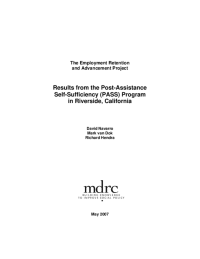Results from the Post-Assistance Self-Sufficiency (PASS) Program in Riverside, California
The Employment Retention and Advancement Project
Although much is known about how to help welfare recipients find jobs, little is known about how to help them and other low-wage workers keep jobs or advance in the labor market. This report presents an assessment of the implementation and effects at the two-year follow-up point of a program in Riverside County, California, that aimed to promote job retention and advancement among employed individuals who recently left the Temporary Assistance for Needy Families (TANF) program, the cash welfare program that mainly serves single mothers and their children. The study is part of the Employment Retention and Advancement (ERA) project, which is testing 15 programs across the country (including two programs in Riverside). The ERA project is being conducted by MDRC, under contract to the Administration for Children and Families (ACF) in the U.S. Department of Health and Human Services, with additional funding from the U.S. Department of Labor.
This ERA intervention in Riverside County, called the Post-Assistance Self-Sufficiency (PASS) program, was designed to provide former TANF recipients with voluntary postemployment services — such as case management, counseling and mentoring, and help with reemployment — to help them keep their jobs, remain off TANF, and advance their earning potential. PASS is being evaluated using a random assignment research design whereby eligible individuals were assigned, through a lottery-like process, either to a program group, whose members were actively recruited by one of five local PASS service providers to engage in an array of postemployment services, or to a control group, whose members were eligible to receive less intensive postemployment services from the Riverside Department of Public Social Services (DPSS), if they requested such services from DPSS. The outcomes for the control group represent what would have happened in the absence of the PASS program, providing a benchmark against which to compare the PASS program.
Key Findings
- Almost half of the program group received some type of PASS postemployment service, compared with 8 percent of the control group who received any postemployment services from DPSS. Among the PASS group members, case management and counseling was the most common service utilized (by 32 percent), followed by job search activities (15 percent) and referrals to and support for education and training programs (8 percent).
- The PASS program increased employment and earnings during the first two years of follow-up. In an average quarter, PASS increased employment rates by approximately 4 percentage points above the control group average of 58 percent. PASS increased total earnings by $1,791 (about 11 percent) above the control group average of $16,578. Most PASS and control group members left their initial job (the job they held at the time of random assignment) at an equal rate. Thus, PASS had no statistically significant effect on retention or advancement in this job. However, PASS produced employment and earnings increases, mostly because PASS group members were more likely than control group members to find subsequent jobs. The impacts on employment and earnings were evident among three of the five PASS service providers.
MDRC will continue to track employment and earnings outcomes for the study’s participants; although these results are promising, they are not the final word on the Riverside PASS program.






